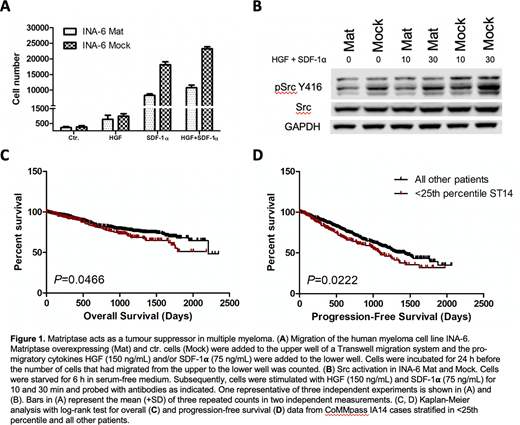Both in newly diagnosed multiple myeloma (MM) and during progression of the disease, malignant plasma cells are found circulating in peripheral blood as well as in the bone marrow (BM). The disseminated nature of MM is strongly dependent on the interplay between the cancer cells and the BM microenvironment, promoting myeloma cell migration in the BM. Matriptase (ST14), a type-II transmembrane serine protease primarily found in epithelial tissues, is overexpressed in a variety of human malignancies and is sufficient to induce tumour formation in mice. Frequently, a concomitant reduction in the levels of its cognate inhibitor hepatocyte growth factor activator inhibitor (HAI)-1 (SPINT1) is observed in carcinomas, while expression and function of the related inhibitor HAI-2 (SPINT2) is yet to be clarified. Dysregulated expression causing increased matriptase proteolytic activity has been associated with cancer growth, survival and metastasis. Here, we show for the first time a role of matriptase as a possible tumour suppressor in myeloma pathogenesis. Gene expression analysis of primary cells from MM patients (n=24) and human myeloma cell lines (n=8) revealed highly variable levels of matriptase, HAI-1 and HAI-2. This observation prompted us to investigate the functional role of matriptase in vitro. We showed that stable overexpression of matriptase in INA-6, a MM cell line with no endogenous ST14 expression, reduced migration by more than 50% in response to the combination of the pro-migratory cytokines stromal cell-derived factor-1 alpha (SDF-1α) and hepatocyte growth factor (HGF, Fig. 1A). Conversely, stable knockdown of matriptase in two MM cell lines with high endogenous matriptase expression (RPMI-8226 and JJN-3) significantly enhanced migration in vitro. Mechanistically, matriptase overexpression blocked activation of Src kinase (Fig. 1B), well-known as a critical player in metastasis formation promoting cancer cell motility, invasiveness and angiogenesis. In agreement with our result, previous studies have demonstrated the activation of Src family kinases (SFK) downstream SDF-1/CXCR4-signaling. Finally, we performed survival analyses in the public available MMRF CoMMpass trial database (release version IA14). Low ST14 expression was associated with significant worse overall survival (P=0.05, Fig. 1C) and progression-free survival (P=0.02, Fig. 1D). Altogether, our data are in marked contrast to the role ascribed to matriptase in epithelial and certain non-epithelial tumours as an oncogenic protein and an unfavourable prognostic marker. In conclusion, these findings suggest a novel role of matriptase as a tumour suppressor in MM pathogenesis.
Slørdahl:Celgene: Consultancy; Janssen and Celgene: Honoraria.
Author notes
Asterisk with author names denotes non-ASH members.


